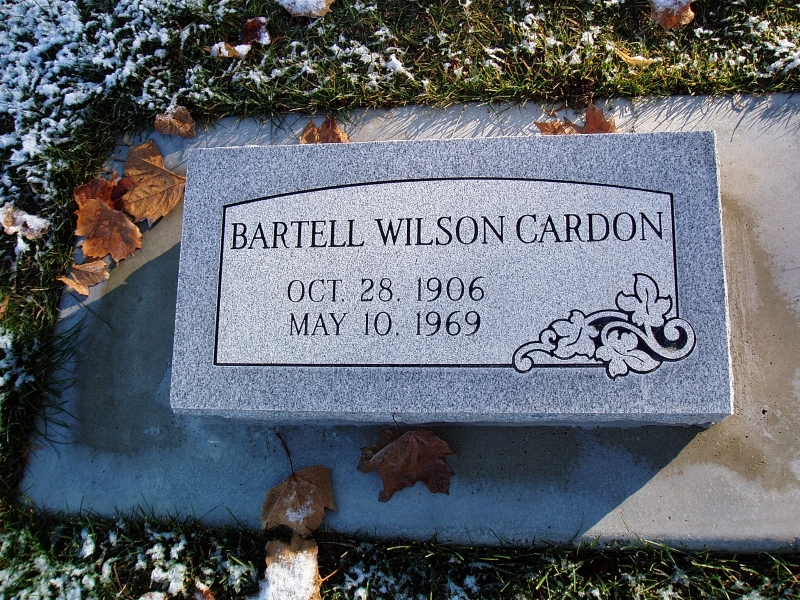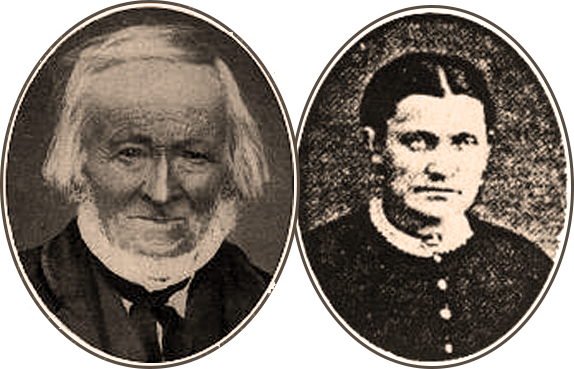28 Oct 1906 – 10 May 1969
Great-Grandson of Philip Cardon and Martha Marie Tourn
Grandson of Jean Paul Cardon and Susannah Goudin
Son of Joseph Emanuel Cardon and Sarah Sophia Wilson
HE LOST HIS WAY
Biography of Bartell Wilson Cardon, Sr. (1906-69)
by Bartell Wilson Cardon, Jr.
Bartell Wilson Cardon (Bart) was born in Logan, Utah, USA, on October 28, 1906, to Joseph Emanuel Cardon and Sarah Sophia Wilson. Logan is located on the east side of Cache Valley in Northern Utah. It was founded in 1859 by settlers sent there by Brigham Young and incorporated January 17, 1866. The new community was named “Logan” in honor of Ephraim Logan, an early fur trapper in the area.
Grandparents
Bart’s grandparents were among the earliest settlers in Cache Valley. The parents of Joseph Emanuel Cardon, Jean Paul Cardon (1839-1915) and Susannah Goudin (1833-1920), settled in Logan in 1861, having moved from Ogden, Utah. Susannah had arrived to Utah in the first handcart party, entering the Salt Lake valley in 1856. Sarah Sophia Wilson’s parents, Joseph Wilson (1844-1933) and Mary Ann McCornick (1846-1913), arrived to Newton, Utah, in 1868 from Stockport, Cheshire, England.
Parents
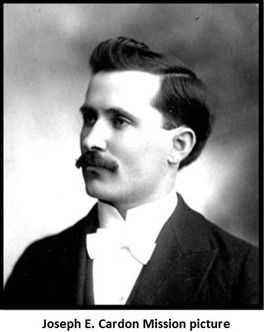
Bart’s father, Joseph E. Cardon (1872-1956), hereafter referred to as Father Cardon, has an interesting history which must have influenced his children in a variety of ways. He graduated from Brigham Young College in 1894. He then taught in the Logan City schools for two years. He married his sweetheart, Sarah Sophia, just a few days before his departure (1896) to the Northern States Mission. He passed his first year in Indianapolis and became the president of the Indiana conference. He was transferred to Chicago and appointed secretary of the mission, devoting more than 18 months to that work. That labor required that he travel extensively throughout the various states of the mission, assisting in holding conferences with missionaries and local members of the Church. He was released in 1899, returned home and began his family, professional, and community service life.
He was immediately called as a special missionary to labor in the Cache Stake, set apart as a president of the 64th quorum of the Seventy, and secretary of the Cache Stake Sunday School Board. In 1901 he was ordained a Bishop and presided over the Logan First Ward. He was released in 1905 and called as Second Counselor of the Stake Presidency in 1906, about the time of Bart’s birth. He was ordained as Patriarch in 1913, and was called as a missionary to Missouri a few months later. He served as the Logan stake president for twenty years. He and the family had ongoing interactions with General Authorities, often hosting Church Presidents, their counselors, and members of the Twelve and Seventy in their home.
Father Cardon was an entrepreneur and successfully engaged in multiple business ventures. Upon returning from his first mission, he and Melvin Ballard (who later became a member of the Quorum of the Twelve) organized the Logan Knitting Factory. He served as president and continued with that enterprise for eight years. Father Cardon was part owner and manager of a department store, became a partner in the Cardon Company, had a real estate company, and engaged in many other business endeavors along the way.
Joseph E. Cardon also was a community activist. He served on city and county councils and was a state legislator in 1913, 1917, and 1919. He attended the National Democratic Convention that nominated Woodrow Wilson as candidate for President, and he was a member of a small group assigned to notify Wilson of that nomination.
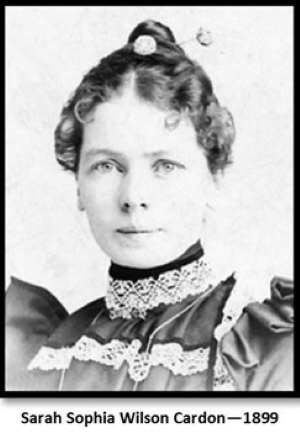
Sarah Sophia Wilson Cardon (1870-1948), Bart’s mother (hereafter referred to as Mother Cardon), was a homemaker, missionary, and community socialite. Although little has been written concerning her life, she was known for having great influence upon her family and having major sway within the social community. She was supportive of, and in many instances a partner in, her husband’s many religious, community, and professional endeavors. She was known as a perfect hostess to all who came into her sphere of influence.
Logan, the home and community of Bart’s youth
Logan was laid out in the traditional Utah fashion, with Main Street running north and south and Center Street going east and west. Blocks were roughly 1/10th of a mile long and wide, and addresses were calculated by their locations in relationship to the intersection of Main and Center. The Cardon home was two blocks north of Center Street and approximately half a block west of Main Street.
US Census reports list the population of Logan in 1900 as being 5,451 individuals and increasing to 7,522 by 1910. Homes were being built around the small business core of the city and radiating out from there, with outlying lands used primarily for farms. The streets were slowly being paved, at least in the very central part of the city.
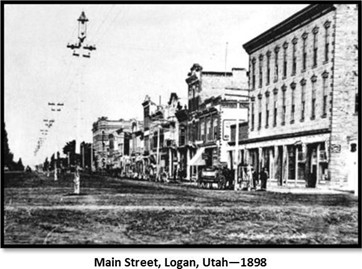
Basic utilities, such as running water, electricity, and sewage disposal, were in their infancy. For example, “In the late 1800s the Hercules Power Company owned a hydro generation plant at the mouth of Logan Canyon. Hercules had been charging Logan citizens a flat rate of $1.25 per month for the first light bulb and 50 cents per month for each additional lamp.” (A Brief History of Logan City Power and Light, Logan City, 2016). To put these prices into context, paying $1.25/month for the first light bulb and .50/month for each additional one would be equivalent to paying approximately $36.00/month today (2016) for the first light bulb and $14.40 for each additional one. Only the most prosperous families had electrical lights at the time Bart was born. His was a prosperous home.
Bart’s birth
Although there is no formal or official record of Bart’s birth, it is highly likely that he was born, as were his older siblings, at the Cardon home located at 56 West and 200 North. The first hospital (Budge Clinic) was constructed in 1914.
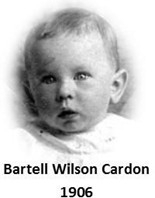
Bart was the fifth of eight children. His older siblings were Joseph LeGrand (1900- 1900), Rula (1901-1985), Sybil (1903-1992), and Joseph Emanuel Jr. (1904-1910). Karma (1908-1990), Virginia (1913-1920), and Blanche (1915-2004) were his younger sisters. According to the 1900 US Census, there was a 16-year-old female “servant” living in the household by the name of Florence Wilson, who was actually the youngest sister of Mother Cardon; the 1910 US Census lists Emma Trchnie, a 32-year-old female from Germany, as a resident “servant.”
Sybil, Bart’s older sister, described their home setting in the following words, “We had a wonderful happy home. My father and mother lived and loved the gospel and taught it to us. To begin with our home was a modest frame house, and so as each child joined the family an extra room was added, Then the house was lustered and stuccoed. We had an old fashioned coal stove in the kitchen and a round iron one in the front and dining room. Father would arise early and make the fires, then we would all huddle around the stoves to dress…. Our Christmases were looked forward to with great anticipation and joy. We all received one gift and were delighted with it. It was a real treat to have an orange in our stocking. Father always told us the story of Christ and why the day was so important. We would assemble a basket of food and take it to a needy person as part of the day’s activity. We were taught to be unselfish and to be grateful for our blessings” (SCK).
The Cardon family was not free of challenges or tragedy. The first son, Joseph LeGrand, was born in April of 1900 and died in December of that same year. Another death of a sibling, Joseph Emanuel Jr., occurred in 1910 when Bart was four years of age. Sybil wrote, “My brother Joseph died Dec. 1911 [actually December 15, 1910] of Diphtheria. We were all quarantined and a private funeral was held as the disease was so contagious. No one but a doctor and nurse came into our house for several weeks. Groceries were left on our back porch. It was near Christmas and gifts were handed to my father through a window of the house” (SCK). Upon the death of Joseph Emanuel Jr., Bart found himself the only son and shared his parents with two older and one younger sisters – Rula, Sybil, and Karma. Three years later, in 1913, another sister, Virginia, was born. She would die just seven years later.
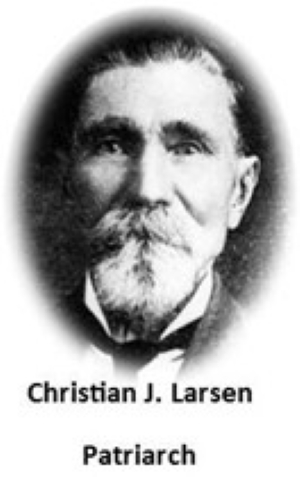
It was almost a year to the day (December 13, 1911), following the death of Joseph Emanuel Jr., that Father Cardon took Bart, just five years of age, to have his patriarchal blessing. Father Cardon was the bishop at the time, and the Patriarch was a remarkable man by the name of Christian J. Larsen. The custom of that day was for patriarchs to pronounce a combination of a father’s blessing and a patriarchal blessing. The blessing began, with Father Cardon acting as scribe, “Brother Bartell Wilson Cardon, I place my hands upon your head, in much humility, and ask God the Eternal Father, in the name of Jesus of Nazareth, that his holy Spirit may indite [to write, compose] your blessing through me and by the authority of my calling, I confer upon you a father’s and a Patriarchal blessing, together with all the blessings of the New and Everlasting Covenants, and say unto you, always respect and honor your parents, seek their councils all the days while they live with you, and you shall be guided aright and your mind shall expand.” The full blessing is truly beautiful, with promises that any individual who loves the Lord would wish to receive. It came with a stern warning, however. “Beware of the sophistry of men for that will make you weak. You will be tried even as gold, seven times in the fire…. When you get to years of maturity read these sayings; ponder over them in your mind and strive to live up to them and you shall know they are the word of the Lord your God and give glory to Him for it.”
Parent’s mission to Independence
Father Cardon received a mission call during mid-1913. He was asked to move to Independence, Missouri, to work as editor of the Liahona, The Elders Journal. His daughter, Sybil, in her autobiography, described the call in these words, “When I was ten years old my father was called on a mission to Independence, Missouri, to edit the Liahona, The Elders Journal. In spite of his many financial responsibilities, he did not question the call, and with his wife and five small children left for the mission field” (SCK).
Sent July 7, 1913, his acceptance letter was brief and to the point. He was set apart for his calling on August 29, 1913, by Francis M. Lyman, President of the Quorum of the Twelve Apostles. Mother Cardon, having given birth to Virginia in July, was set apart October 9, 1913, by Seymour B. Young, President of the Seventy.
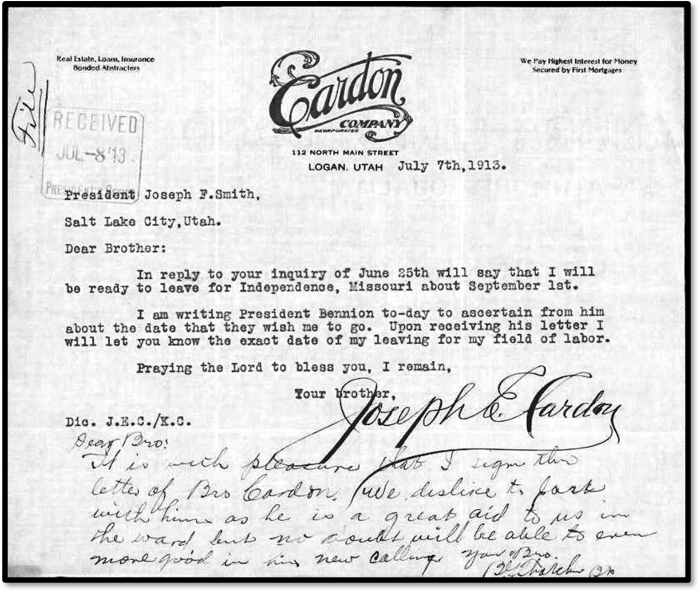
Bart was not quite seven years of age when the family moved to the Central States Mission. They traveled by train and had their car shipped. “We took to Missouri with us our old red Studebaker, one of the first automobiles in Logan. It had two camp stools under the back seat for extra passengers. There were no side curtains, so we always wore ‘dusters’ to keep the wind and dust from devouring us. We were so proud of this car we decided to have it shipped to Missouri. When the car was unloaded at Kansas City and we all piled in we were embarrassed by all the stares and glances. The automobile was really out of date and very different than the ones we saw in Kansas City. It wasn’t long before my father turned it in on a more modern one” (SCK). Mother Cardon’s father, Joseph Wilson, was invited to join the family the following year to assist Father Cardon with the publishing of the Liahona.
The family moved into a home across the street from the Central States Mission residence in Independence. Samuel O. Bennion was Mission President at that time, and the Cardon family and the Bennion’s interacted on a regular basis, often traveling together to Kansas City on special occasions (SCK).
The children were enrolled in the local public school system. Sybil described her experiences in this fashion, “I entered school in the fifth grade and became an object of curiosity, as it was announced that I was a Mormon from Utah. At recess I was surrounded by children wanting to know where my horns were. Needless to say, my school year was not very happy. The children would play with me at school, but their parents discouraged any close friendship. However we had wonderful association with the few members from church. The missionaries that lived in the home [across the street] visited us very often. The lady missionaries took a special interest in my sister Rula and I” (SCK). Bart, three years younger than Sybil, would have been in the first or second grade at the same school, and it is doubtful that he escaped similar bullying.
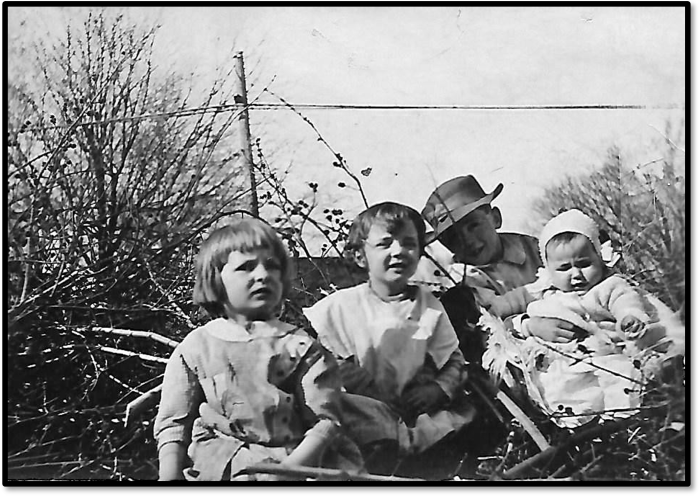
There are several significant events pertaining to 1914. The printing press used to publish the Liahona was badly damaged by vandals while the family was on a visit to Kansas City (SCK), one of a number of indications that Mormonism was not highly regarded in that area of the country. The First World War began in Europe in the latter part of July, and that would have created a local stir. And, most important, Bart was baptized by his father and confirmed a member of the Church by E. Ray Guyman on November 22 (LDSM).
Family, school, Church and social activities continued. Another sister, Blanche, was born in 1915. Father and Mother Cardon were released from their missions in 1916, and the family returned to Logan. Father Cardon was reelected to the Utah legislature, serving in 1917.
World War I
The Cardon family was living in Independence, Missouri, when World War I began in Europe on July 28, 1914. However, America embraced a policy of isolationism. It wasn’t until April 6, 1917, that the United States entered the conflict, and by then the Cardon family was back in Logan.
There would have been a good deal of public commotion regarding the war, with heightened patriotism, rallies, and military enrollment going on. America was at war, and the military needed men, and some women, to bring about victory. Twenty-four million men who were born between 13 September 1873 and 12 September 1900 (between the ages of 18 and 45) registered for the draft. Not all who ultimately found themselves in the military met the age criteria. In their enthusiasm, some underage men were less than truthful about their years of birth.
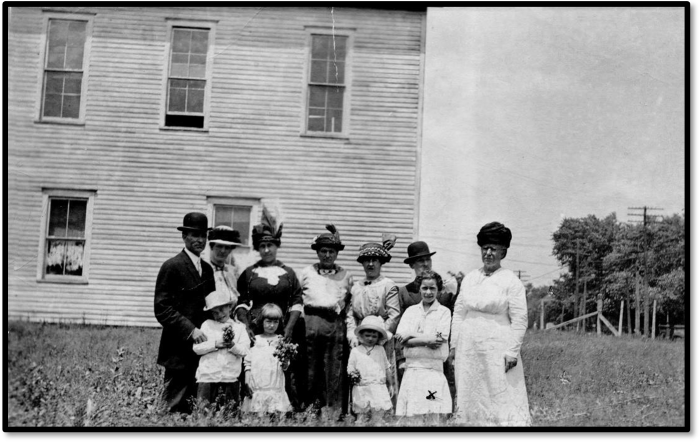
Bart, Karma far left front – Sybil second from right front
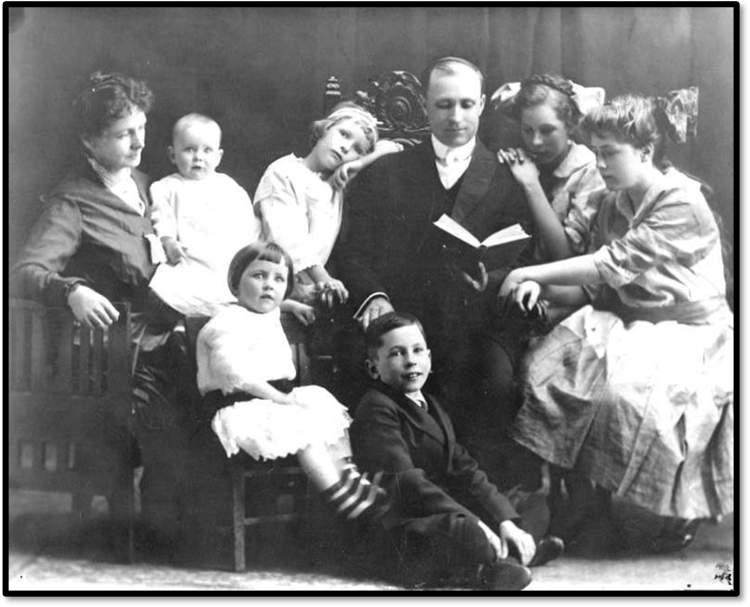
One of the stories that has been passed down by some members of the Cardon family is that Bart, as a youth, ran away from home and joined the cavalry, and that Father Cardon, then a state legislator, was able to track him down and have him returned home. There is one document that indicates that it is possible that Bart actually was in or with the military in one capacity or another—a postcard sent from France to his older sister Rula. There are several rather remarkable features of the card that create a fascinating mystery. First, and foremost, is the date stamped on the card, September 30, 1918 (the war ended just six weeks later on November 11, 1918). Bart was born October 28, 1906, which means that the card was stamped in Bordeaux, France, when he was only eleven years and eleven months of age! Second, the postcard appears to have been written in his handwriting (based upon comparison with a few samples) and has his signature. Third, the postcard is one of many YMCA cards that were used during WWI by servicemen overseas, this one apparently even signed on the front by an inspector vouching that it contained no secret information.
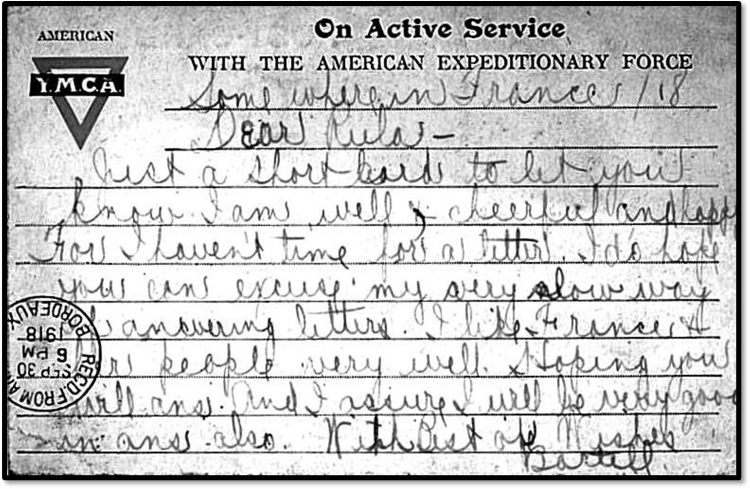
The note says, “Some where [sic] in France 1918 Dear Rula – Just a short card to let you know I am well and cheerful and happy. For I haven’t time for a letter. I do hope you can excuse my very slow way of answering letters. I like France & her people very well. Hoping you will ans. And I assure I will be very good in ans also. With Best of Wishes Bartell”
There are some interesting features regarding the front of the postcard. It is addressed to “Miss Rula Cardon” at the Logan home where she was at the time. It does have the additional information needed to get the card to the United States from France, not in Bart’s handwriting. There is what appears to be the inspector’s signature and “OK.” However, the “Reply to” information is not that of Bart, but of someone by the name of what appears to be “Wag B.F. Jeppesen US Army.” The Wag could designate the rank of Wagoner, which would have been associated with a military teamster or driver during WWI.
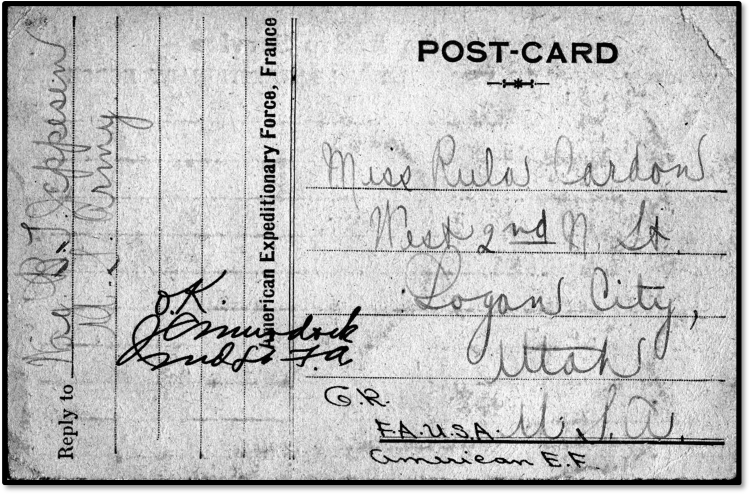
The primary question is, was he or was he not in France in 1918? If he was, how did he get there and in what capacity? Who helped him, and what was the motivation? Could he have been employed in some role, such as stable boy (some in the Cardon family believe that Bart came back willingly because he didn’t like having to clean up after the horses)?
Could it be that he never actually was in Europe at the time, that he somehow arranged for the postcard to be sent from there to hide his actual location from his family? If so, why was he running away from home? And, of course, there is the problem of determining who the Jeppeson individual was. A few Jeppesen families did live in and around Cache County at that time, and it is certainly possible that one of the men may have been in the service and consented to assist Bart in his deception. A search for someone with similar initials has not located the individual. And so, this continues to be one of the tantalizing mysteries associated with the youthful Bart.
High School
As best as can be determine, Bart was back in Logan, if he ever left, from 1919 through 1925, ages 13 to 18. During that six-year time span, his father was elected to the 1919 Utah legislature and was sustained as a stake president. Although the Cardons are missing from the 1920 US Census, there is little doubt that the family was in Logan. That was the year Virginia, Bart’s youngest sister, died.
In 1921, according to Father Cardon’s diary, Bart underwent a tonsillectomy on March 1 at the Utah-Idaho Hospital (JEC p. 3). He would have been 14 years of age at the time. Later on in the year, July 19th, Bart was hit by an automobile owned by “N. Sorensen. “ That resulted in his right leg being broken above the knee and a good deal of bruising. He was again treated at the Utah-Idaho Hospital, remaining there for approximately 24 hours (JEC, p. 5).
Bart attended the Brigham Young College (BYC) between 1922 and 1925. BYC was established to provide higher education to the youth of The Church of Jesus Christ of Latter- day Saints in northern Utah, southern Idaho, and western Wyoming and had nearly 40,000 students in its nearly fifty years of operation. During the period of 1910-1926 the school operated as a high school and junior college. In 1926, only one year after Bart’s last class there, the Church Board of Education of the Church Educational System decided to close its educational institutions, except for Brigham Young University. BYC buildings were sold to the city of Logan and were used as a high school for a time.
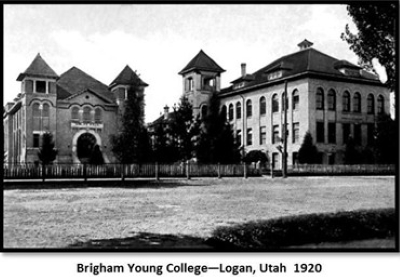
Bart was not a particularly good student, as least as defined by his grades. His best recorded marks were a B plus in algebra, Bs in biology and English, and a B minus in typing. The other grades were in the C range, with one D in American history. There is a rather obvious trend—his grades were progressively lower over time. Given that his earlier grades were considerably better, it could be assumed that he was not motivated his last year to do as well. He was going to school, but he may not have wanted to be there. Father Cardon, Mother Cardon, and older siblings had all attended BYC and were excellent students, some obtaining what today would be called a BA or BS degree. Why was Bart not following that pattern? His earlier much better grades in Algebra and biology indicate that he had the necessary capacity to do significantly better. His grades in the 1924-25 school year suggest that he wasn’t willing or able to apply that aptitude.
An important question regarding Bart’s high school education is a simple one—did he graduate? There is no record that he did, but that in and of itself does not prove that he did not. The current (2016) Registrar at Logan High School, in reviewing the transcript, wondered if Bart had sufficient credits to graduate. The key to understanding the number of credits has to do with correctly interpreting what is written over the Cr. in the 1922-24 credits column. If the write-over is “hrs,” which upon magnified inspection appears to be the case, then he may have had sufficient coursework to leave BYC as a graduate. The Registrar didn’t know the exact graduation requirements that applied in 1925. The question remains, therefore, did he graduate? As none of his future work situations required a high school diploma, his job titles don’t help answer that question.
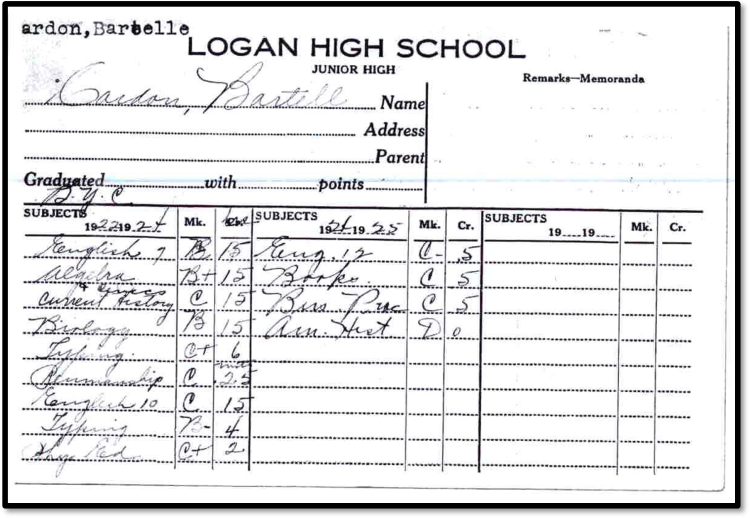
BYC was developed upon the same principle as was Oberlin College, that the students assisted in reducing the cost of their education by working a given number of hours each week without compensation. It is probable that Bart did earn some or all of his tuition through prescribed labor. However, there are a number of notes within his father’s journals indicating that Bart received an ongoing allowance and additional money for fees, books and supplies (JEC 8, 15, 16, etc.).
Mission to central states
Another family story regarding Bart is that Father Cardon sent him off on a mission with the hope that the experience would “straighten him out.” Whether that is true or not, Bart did go out on a mission to the Central States, leaving at the age of 18. His father’s diaries contain two brief notes that provide the core fact of his departure. On April 7, 1925, his note is “Bartell to leave for his mission” (JEC, p. 18). Then, on April 15 of the same year, his note reads, “Bartell leaves S.L. for his mission to the Central States” (JEC, p. 18). Additional information is found at an LDS missionary website (LDS). It indicates that Bart was set apart for his mission on April 9, 1925, by Richard R. Lyman of the Quorum of the Twelve Apostles.
Just how long he remained in the Central States Mission is unknown. There have been stories within the Cardon family suggesting that he returned home early. There isn’t any available evidence one way or the other. Unfortunately, Father Cardon’s diaries for 1927- 1929 have not be located, and mention of his return would likely have been there.
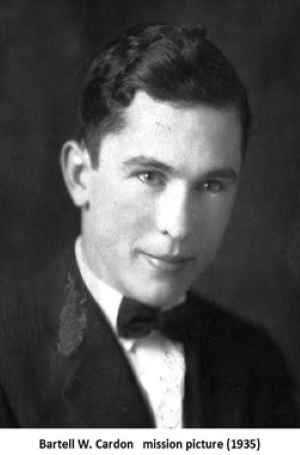
Two mission addresses have been found, both written at the end of the 1926 diary of Bart’s father. They are 530 W. Morgan Street, Denison, Texas, and 713 First Avenue, Dallas, Texas. As neither a 1925 (a transcription is available for this year, but not the actual book) nor a 1927 diary has been found, addresses before and after the two Texas locations, if there were any, are not known.
Four books which Bart took on his mission have been located. The first is the Holy Bible. Although there are no markings or underlining on the pages, it contains (as a bookmark?) what appears to be the cutout lower corner of a page from some publication for members of the Church (based on wording on one side), possibly from the Liahona. It reads, much like a poem Father Cardon would have written,
“I cannot say, I will not say that he is dead—he is just away. With a cheery smile, and a wave of the hand, he has wandered into an unknown land, and left us dreaming how very fair it needs must be, since he lingers there. And you, O you, who the wildest yearn for the old- time step and the glad return, think of him faring on, as dear in the love of There as the love of here. Think of him still as the same, I say. He is not dead, he is just away!”
The second book is a 1917 edition of the Triple Combination. The Book of Mormon is underlined periodically in red from 2 Nephi 26:20 through Jacob 2:30. Sections 2 and 4 of the Doctrine and Covenants are marked in their entirety, and 76:50-89, 89:18-21, 93:38, and 132:4-6, 8-12 are also underlined.
The third book is A Key: Succession in the Presidency and Ready References printed by Sanders Book Co. This small volume was first owned by Father Cardon (his name is stamped on the inside cover) and passed on to Bart for his mission use (Bart wrote Central Mission after his own name). There are no additional markings.
The last of the four books is the 1920 edition of A Brief History of The Church of Jesus Christ of Latter-day Saints. What makes this volume unusual is that Bart wrote his name on the inside cover and gave his location as “Independence, Mo.” This could indicate that Bart, who served in Texas (Denison and Dallas) in 1926, may have been first assigned in 1925 to work in Missouri and then transferred to Texas from there. The alternative possibility is that Bart began his mission in Texas and was transferred to Missouri. If that is the case, his Missouri service would have been in 1927, as only Texas addresses were listed in his father’s 1926 diary.
There are two individuals who knew Bart in the mission field and who briefly shared their impressions with Bart’s son. Bart Jr., who pronounced the grave dedication at Bart’s 1969 funeral service in Logan, describes those interactions in this fashion, “One person present at the graveside service was from Cove, a small rural community up near the Idaho border. Lingering to talk with me, he mentioned that my father had been one of his missionary companions and that my father had been a good missionary…. Ten years later, in 1979, I received correspondence from Arthur R. Busick in which he asked about my father…. It seems that my father helped this man become active in the Church and became his ‘close’ friend. The letter ended with these words, ‘Your father was one of the finest men I ever knew and [I] will always treasure the memory of him being in Dallas’” (BWC, p. 275). Apart from the matter of Bart’s length of stay in the mission field, the two witnesses to his service indicate that he did have an impact for good.
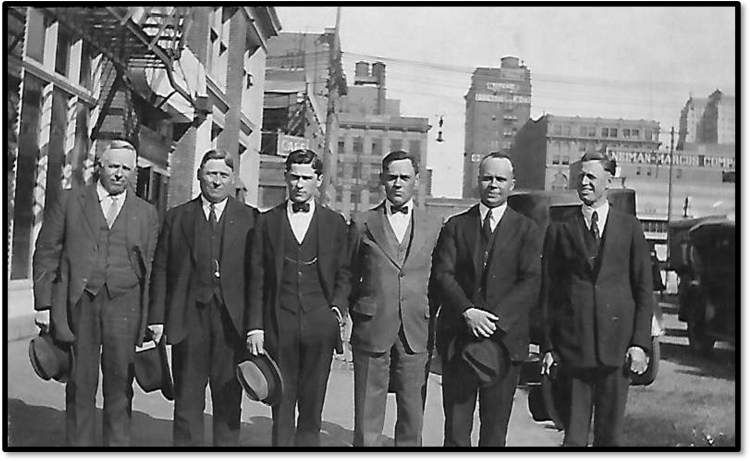
Marriage and Denver years
If Bart returned from the mission early, it likely would not have been before mid- 1926, and if he completed his mission, he would have returned to Logan in April or May of 1927. It is known that he was in Logan in 1929, and he was listed in the US 1930 Census as a “boarder” and “guest” in the household of a 72-year-old female by the name of Jane B, Muir. He was 24 years old at the time and was living apart from the family, but nearby.
Although Bart was listed as being in Logan during 1929 and 1930, his future wife, Blanche Irene Alsop (1900-1987), stated in her autobiography that he was in Denver some of that time. She recorded that she was introduced to Bart in the fall of 1929 by a friend, Jack Payne. This is how she remembered the event, “When we went to the check stand to check my wrap, Jack Payne knew the attendant. Before I knew it, I heard, ‘Meet my friend, ‘Bart Cardon.’ While they talked for a moment, I made my assessment. All I could see at that moment was a young man, very thin and much too pale.” (BIC, p. 64) She indicated that he was gone two weeks later. It would seem that Bart had traveled to Colorado on previous occasions and knew several individuals there. Moreover, he appears to have had the notion of moving there.
Blanche was a boarder at the home of Jack Payne and his family. Bart showed up at their door in the Spring of 1930. “The doorbell rang and there was Bart and a friend. They were tired and hungry, and he looked terrible. He hadn’t had a haircut for a long time. He asked Jack if he could borrow fifty cents so he could get his hair cut and be presentable by Monday to look for a job. Jack didn’t have any change, so I gave it to him. … He was able to get a job with Ford Motor Company two or three days a week” (BIC, p. 66). Bart moved into the Payne home shortly thereafter. He and Blanche began to date.
While Bart and Blanche were on a holiday at Estes Park outside of Denver (it was Mother’s Day, 1931), Blanche “…asked Bart the difference between being a Methodist and a Mormon. He answered that his church had the authority to marry for time and eternity. That answered a lot of questions for me, and as soon as I heard it, I knew that Mormonism was true from the way I felt inside. …Many times I have thought about that wonderful weekend, and have always felt that the Gospel came to me in the most wonderful place in the world – high in the Colorado Rocky Mountains” (BIC, pp. 67-68).
Bart married Blanche on July 11, 1931, at the LDS Mission Home in Denver, Colorado. President Woodruff performed the ceremony. Sister Woodruff and two sister missionaries were the witnesses (BIC, p. 68). As Blanche was little informed regarding Mormonism, the place of the wedding and who performed the ceremony would have been Bart’s idea, thus indicating that he was not particularly antagonistic towards the Church at that time, or it could simply be that it was a financial decision, given that there would have been no marriage costs at the mission home. From that point on, they may have lived at 1039 East 13th Ave., Denver, then moving to 1755 Grant Street, Apt. 11, also in Denver (JECN).
The Great Depression was in full force all across America, with unemployment high. Blanche put it this way, “Our menu got skimpier all of the time. Finally, we were reduced to almost a full-time diet of navy beans, bread and butter. Those were the days before electrical refrigeration. We tried to keep at least 25 cents worth of ice in a little wooden ice box in our kitchen. This had to last a week, which it never did, so before the week was out even our beans got a little sour. Finally, one night we saw an ad in the paper stating that the Western Auto Company was holding an open house the next day. Refreshments would be served. We hurried down the next day, giving ourselves plenty of time, or so we thought. When we got there, the line went almost around the block. By the time we got to the refreshment table all that was left was some warm punch. I put my fingers in the cookie tray and scraped up some of the crumbs” (BIC, p, 69).
Bart was listed in the 1932 Denver city directory as a “Trimmer.” Exactly what that referred to is unclear. He could have had some work at a book bindery or at a butcher shop or as a gardener. Blanche was soon pregnant. Her work situation was reduced to piecemeal opportunities; Bart lost his job at the beginning of 1932, and he went on W.P.A., “a hard job cleaning streets in all kinds of weather” (BIC, p.69).
Bartell Wilson Cardon, Jr. was born April 21, 1932, at Denver General Hospital. At that time, Bart was working two or three days each week, at most. Although he wasn’t there for the delivery, he arrived soon after. This is how Blanche portrayed that meeting, “Bart had been called back to work the night before, so he asked the doctor the next morning if he should plan to go to work. The doctor was brusk and told him unless he planned to have the baby, he should go to work. He took me to the hospital about six thirty as he had to be at work at seven that day…. Bart arrived at the hospital about four-thirty. I had just received my dinner tray and on it was steak, vegetable, potatoes and gravy and milk. He had worked all day with nothing to go home to so I told him I had an upset stomach and asked him if he would eat my dinner. That night at nine, they brought around milk and cookies. I asked for seconds” (BIC, pp. 70-71).
Blanche brought Bart Jr. home; soon after, she and Bart decided to rent a house and let out rooms in an attempt to improve their financial situation. That resulted in a slight improvement but had its problems as well. Bart was unable to provide sufficient income to sustain the family. Changes had to be made.
Return to Logan
There was correspondence going on between Bart and Father Cardon that ultimately resulted in the decision that Bart would return to Logan, where he was to work part time in his father’s office. Blanche “was very much for it, as I was anxious to really study the Gospel…. Bart was the only Mormon I had ever been around and was acting no differently than anyone else. I felt that wasn’t quite right. Also, his friends, I thought, were of poor quality. I was putting up with profanity, vulgarity, liquor, something entirely foreign in my entire life” (BIC, p. 72). She describes how one of Bart’s friends had recently been in an armed robbery and was sent off to prison, leaving a pistol with Dad.
While Blanche and Bart Jr. visited with family for a month in Iowa, Bart moved their few belongings to Utah. His parents were in California when Blanche and Bart Jr. arrived to Logan, so they had the large home to themselves for a time. When the parents returned in the second week of January 1933, Blanche found that Father Cardon “was all that Bart said he would be, warm and friendly” (BIC p. 73). Her description of Father Cardon was accurate, for he was known both inside and outside the family for being emotionally stable, never overreacting to situations, always gentle and kind. Blanche described Mother Cardon as “reserved.” It may be that Mother Cardon was on her best behavior, for she was known for her strong opinions and occasional emotional reactions to people and situations. Blanche mentioned that the sisters were socially popular and musically talented. It was about this time that “Grandpa Wilson” came to live in the home, so there were four generations living together.
Bart and Blanche were anxious to be more independent and were looking for alternative living arrangements. A representative of the Sorosis Society, a professional women’s association or sorority which later took on the name Pi Beta Phi, phoned the office requesting that a couple be found to live at their house during the summer, June through August,1933. Bart took the information to Blanche, and they decided to move to the sorority house at 33 North 200 East (BIC, p.74).
At the end of the summer, Bart located a duplex at 233 North 300 East. It was reasonably priced and had most fixtures, although they had to use the oven to heat the house. The other tenants were students at the college, and they tended to steal coal from Bart’s limited supply when theirs ran out (BIC, p. 74).
It was September 25th when Bart came home for lunch. He was in “a depressed mood.” Upon arriving to the office that morning, his father had told him “that the family was going to Salt Lake City to attend the wedding of Bart’s younger sister, Karma, and Harry Woodward.” Bart was both deeply hurt and angry that not only was he not invited, but no one had even told him of the upcoming wedding (BIC, p. 74). This is one of only three occasions wherein Blanche refers to Bart’s emotional status, all related to his being angry (see BIC, pp. 75, 84). No other references to his moods were found in any of the other documents located.
This occurrence must have been a key event for Bart, but why? The answer may be in what appears to be a family characteristic of not sharing, even between family members, information that was unflattering or unbecoming or considered too private for open discussion. So, it may be that there was something about the wedding, at least in the minds of Father and/or Mother Cardon, that was not to be shared. One granddaughter of Father and Mother Cardon described the family silence, parroting the opinions of other grandchildren, this way, “My parents didn’t talk about their past or other relatives at all. I wish they had.”
It is possible that Bart may have been mistaken in his conclusion that he was the only member of the family uninformed or uninvited. It could be that Mother and Father Cardon were of the opinion that nothing needed to be shared, even with other members of the family. There are many questions related to this event that could be asked for which answers are not presently available. What does appear apparent is that the family was not as harmonious or open as it may have appeared from the outside.
“Early in March, 1934, Bart had an emergency appendectomy.” Blanche continued her narrative, “Dad came immediately to pick up Junie [Bart Jr.] and me and took us down home so we wouldn’t be alone. Nearly two days passed before Dad thought I should go to the hospital. He was afraid the ether smell might do something to my pregnancy. By the time I got there, Bart was very upset with me, and his first remarks were very caustic. …After that I insisted on going back to our apartment where I could walk to the hospital” (BIC, p. 75).
The next Logan residence was what Blanche referred to as the “Reese home” at 35 North 100 East (BWC, p. 7). Ronald Alsop Cardon was born June 6, 1934, at the Budge Clinic (hospital), while the family lived at the Reese home. “Bart was very nervous, as the doctor had told him he could be in the delivery room with me. After I had been prepped, he was given a watch and told to clock my pains. I was given no medication and was in great pain. He wasn’t prepared for that…. He shook and perspired, and I felt sorry for him as I knew his ordeal was almost as great as mine” (BIC, p. 76).
“When Ronald was about three months old, Dad said he should be blessed. This was the first I had heard about blessing babies. As we made preparations, I should have asked more questions. Junie had never been blessed, but somehow, I got it in my head that blessings were for small babies…. I suppose Bart didn’t want his father to know that he had not seen to it, and I suppose Dad naturally supposed that it had been done…. So, on September 2, 1934, we went to the Fourth Ward and Ronald was blessed by his grandfather. That was the only time that Bart went to church while we were in Logan” (BIC, p.77).
Later in September, the family packed and moved again, this time to the “little red house” at 235 East 400 North (BWC, p. 7). While there, Blanche worked at Budge Clinic for a number of months and paid off her financial obligations pertaining to Ron’s birth and some of Bart’s bills related to his earlier appendicitis hospitalization.
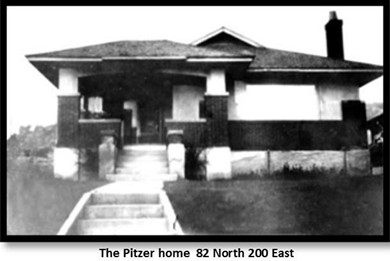
John Pitzer, Rula’s husband, was in the military and was to be transferred out of state in 1935. Arrangements were made for Bart and Blanche to live in their home, located at 82 North 200 East (BWC, p. 8), while they were away on assignment. That home was one house in from the southwest corner of the temple grounds and across the street and down the block from the Sorosis House where Bart and the family had resided during a past summer. John’s orders were delayed, so Bart, Blanche, and the boys found themselves, temporarily, living in the Cardon cabin up the canyon. Once John’s orders did arrive, Bart and family moved into the Pitzer home, the seventh and last location where Bart and his family would live while in Logan. It was about this time that Bart obtained part-time work as a clerk at the State Liquor Store, three nights a week, working from six p.m. to one a.m.
Father Cardon, as an active politician, had a keen interest in local, state, and national affairs. There is an entry in his 1935 diary that relates to Bart and which is particularly fascinating. “Attended Jr. Dem. rally at Sevier High. Bartell presided. He is Pres. of Jr. Democratic Club of C.[Cache] County” (JEC, p. 26). That meeting was held on October 14th. Bart would be 29 years of age in just two weeks.
That event suggests at least two things about Bart and his father. First, Bart was active in community affairs for a time, at least democratic affairs, to the extent that he was the county president of the Jr. Democratic Club. He was, as described by one of his sons, “very charismatic. His smile and laugh were appealing. Even then [1950’s], I could understand why he seemed to have so many friends” (BWC, p. 48). The second thing of note regarding this event is that Father Cardon would take the time and devote his energy to travel with Bart approximately 500 miles (roundtrip) in order to attend the “rally.” Sevier High School was not only a good distance from Logan, but it also was only assessable by less traveled roads. Father Cardon, as reflected in his notes, often went out of his way to support Bart.
“In 1936 [Bart and Blanche] took over a barbeque business across the street from the Capital Theater on Main Street. This was bad from the very beginning. The former owner had skipped out with a lot of bills. We were to take over those accounts and pay on them each week. We were able to make a little money, but not as much as we expected or had been represented to us” (BIC, p. 79). They acquired another barbeque in Tremonton and sold it four months later for a profit of approximately $700.00.
“We needed a car badly. Our old one was costing too much money. Bart decided to take the money he made from the Tremonton barbeque and apply it on a new car. He was told by the dealer he could save money by picking it up at the factory in Elkhart, Indiana, so he decided to do that” (BIC. p. 79). He took “Junie” with him by bus one way and returned two weeks later with a new car.
“Business at the barbeque was dropping off and by early 1937 when our lease was up, we learned the property had been sold and the building was to be torn down. We still owed some of the original bills we had assumed. Bart felt if we rode it out, we would really be in debt, so again we mutually agreed to go to Denver where I would be able to work. None of the family knew about the plans, as Dad would never approve of our leaving under such circumstances. Once again, we locked up our few possessions and early one morning left Logan. I felt badly about leaving without saying goodbye to anyone. I’d never done that before. I was sure that I would be blamed for part of it as least” (BIC, p. 80).
Return to Denver
Blanche was able to secure some secretarial work within days of arriving in Denver, but after a few months she had developed severe and untreatable (at the time) eczema on the hands and was bleeding on the typewriter and documents she was producing. She was unable to continue that work, having to give up her employment shortly before Christmas. Unfortunately, Bart was still unemployed. He decided to take a real estate course and exam and sell houses. He passed the examination but never sold a single home or property, at least as far as Blanche knew (BIC, p. 81).
Bart wrote his father early in January of 1938, requesting monetary assistance. A check was sent immediately (JEC, p. 33). Father Cardon traveled to Denver later in the month to visit Bart and his family at their residence, located at 2320 Gleason Ave. Apparently, Bart had mentioned in his letter that everyone was ill. When Father Cardon arrived, he “found them better than I expected as they all had been sick” (JEC, p. 34).
Moving on to California
Blanche noted that, “Evidently there had been correspondence going on between Dad and Bart that I was not aware of, as after the holidays he came to see us. It ended up that I should take the children and go to Iowa and stay with Mother. I didn’t want to do that as she couldn’t afford to keep us (BIC, p. 81). Regarding the visit, Father Cardon recorded his views of it in this fashion, “This was a beautiful trip and especially that I could be with Bartell and family” (JEC, p. 34). Then on February 11, Father Cardon wrote, “Received telegram from Bartell that Blanche wanted to go to Iowa if I could send them the money. Sent $50.00. They will leave tomorrow” (JEC, p. 34). Blanche wrote, continuing from where she expressed not wanting to go to Iowa, “However, that was the way it ended and the next day we were on the train east. I don’t know what Bart did, the plans for him were never discussed with me. However, my first letter from him some three weeks later came from California. That was a total surprise” (BIC, p. 81).
In the latter part of August, 1938, Blanche received a letter from Bart indicating that he had found work with the Key System and that she and the boys should travel to Oakland (BIC, p. 83). Blanche stopped in Logan on the way. “Everyone seemed glad to see us, and very kind. On the second day we were there, Dad come home for lunch and said, ‘Blanche, you and I have a date this afternoon.’ I was pleased to think that he wanted to take me someplace, so I said, ‘Where are we going dad?’ He replied, ‘To get you baptized in the Logan High School pool.’ I was very surprised and so very relieved. At last they thought I was ready for baptism” (BIC, p. 83). She was baptized on September 29, 1938, by Grant Humphreys and confirmed a member of The Church of Jesus Christ of Latter-day Saints by Father Cardon. He wrote about the event, concluding with these words, “Very pleased about this” (JEC, p. 37). The next day, Father Cardon and his daughter, Blanche, drove Blanche, Bart Jr. and Ron to Ogden, purchased their train tickets, and said goodbye.
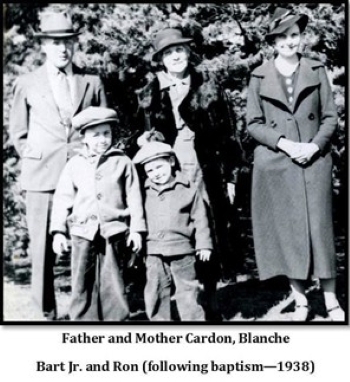
Blanche picked up the story, “We arrived in Oakland during the mid-morning. Bart was working and couldn’t meet us, but Orval Lynch was there. He was the only married friend that Bart and I had in Denver. I was surprised to see him. I didn’t know he and Catherine were living in Oakland. The four of us had shared food in Denver before Junie was born and I considered them the nicest of all of our friends.
“Bart came to their home after work and it was so nice to be with him again. I told him the first possible moment I could that I had been baptized. All he said was, ‘What did you do that for?’ The wind whistled through his teeth as it always did when he was a little disgusted. He never inquired about it later and I never volunteered to speak of it again” (BIC, p. 84).
Their first California residence was at 2210 East, 10th Ave. Apt. 205, Oakland, California. Bart was working for the Key System, driving buses. Bart Jr. was enrolled in the public school system. For a time, Blanche remained home tending Ron.
“Times were hard for those of us who were not connected with defense work in some way. Although I had hoped when we arrived in Oakland that with a little planning it wouldn’t be necessary for me to work, it was soon evident that if the boys or I needed anything, I had to provide it. Bart said he was doing all he could on his salary, and that was true at the time. So long as he was in our home his attitude never changed. He paid the rent and gave me $30.00 a month for food. I bought our clothes, made up the extra that had to be spent for food, paid the babysitter and the $3.00 we spent on one evening a week out to a dinner and a show” (BIC, p. 86).
The apartment had only one bedroom, and there was need for more space. From there the family relocated to 2200 Jefferson Street in Berkeley. A Denver friend, Earl Fireoved, arrived at the door one day and soon was a boarder. The flat worked well for the family, but the owner put the property up for sale, and another move was necessary.
The family next moved into a two-story home in Berkeley, situated on Rose Street. Blanche and the boys “attended the Berkeley First Ward when we could, but it was a long walk from our home. Two lady missionaries were living close by our home. They started a little primary on their own and Bartell and Ronald attended” (BIC, p. 85). Earl Fireoved also boarded there.
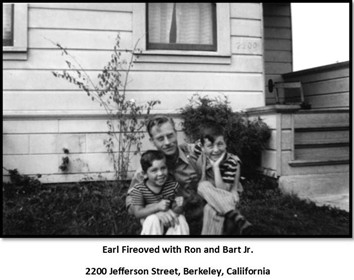
The Golden Gate International Exposition (World’s Fair) was held on San Francisco’s Treasure Island in 1939-40. The LDS Church had a large exhibit hall which had the façade of the Salt Lake Temple at the front. The exhibit hall featured a tall Christus statue and many displays. There also was a chapel with a large organ. Bart’s sister, Blanche, was called by the Church on a mission to the Fair as the organist. Father Cardon and other family members visited the large home on Rose several times. Of one of those visits, February 9, 1939, Father Cardon wrote, “Visited with Bartell and folks most of day. Bought Bartell suit, hat and nice radio, also the boys some clothes” (JEC, p. 40).
Bart Jr. had his eighth birthday in April of 1940. “Bartell had been taught about baptism, and he was anxious to have it done. I had hoped his father would suggest it, but he never did. After waiting three months, I made the arrangements. I asked him to go with us, but he said he couldn’t get off work. The three of us went to the Oakland First Ward, which was the stake center at the time, to have it done on August 31, 1940” (BIC, p. 85).
Bart continued to communicate with Father Cardon. All Father Cardon’s various diary-notes regarding receiving letters from Bart contained just three words, “letter from Bartell.” What was said is not known, but when Bart wrote to his father it often was to share problems and to seek assistance. One “letter from Bartell” notation, without any further comment, was dated December 21, 1940 (JEC, p. 44). The next recorded receipt of a “letter from Bartell” was a month later on January 21, 1941 (JEC, p. 45). Soon after, Father Cardon traveled to Berkeley for a visit with Bart and the family. Blanche was working in San Francisco at the time, which gives Father Cardon’s diary note of February 8th some meaning. “Bartell went to work. Also, Blanche. I went to San Francisco at noon. Blanche I.[Irene] and I went to lunch then to show, then to Berkley [sic.] and spent evening at home” (JEC, p. 46). Again, this note indicates that Father Cardon went out of his way to interact with Bart and Blanche, possibly with the desire of helping Bart overcome financial issues.
Blanche wrote that, “I had been working fairly steady at anything I could get, sometimes in Oakland and sometimes in San Francisco. I finally got a steady job with the Andrew-Breeding Company in San Francisco, another direct mail advertising company. In the meantime, to be closer to San Francisco transportation, and to Bart’s work, we decided to move to Oakland and found a lower two-bedroom flat, partly furnished, at 609-35th Street” (BIC, p. 86).
The Japanese attacked Pearl Harbor December 7, 1941. “Being on the West Coast during the war was rather exciting. There were war related activities all around the area. Several naval bases, army and air force garrisons, as well as industrial plants and other war- related processes were nearby. People were streaming in from other areas of the nation to work, especially from the southern states. Blackouts were introduced almost immediately.
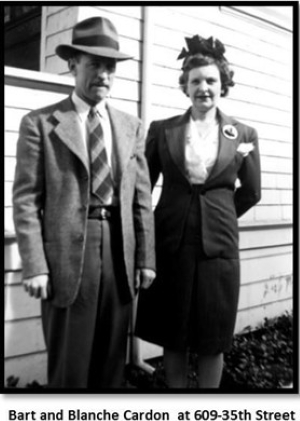
If Japan could bomb Pearl Harbor, then it was likely that the Japanese could reach the West Coast. Antiaircraft guns were placed all along the San Francisco shoreline. Restricted areas and secret military operations popped up everywhere. Japanese submarines were reportedly spotted sitting just off the coast. Invasion scares and rumors were frequent, at least during the first year of the war” (BWC, p. 33).
The family was part of the Oakland First Ward, where Bart Jr. had been baptized the previous year. Blanche, Bart Jr. and Ron were warmly received. “In 1942, Ronnie became eight. I only waited a month before I made arrangements to have him baptized. Bart told me again that he could not get off work, so the three of us went to the ward for his baptism” (BIC, p. 87).
Bart continued to work at the Key System as a driver, until at least 1943. He was listed in the 1941 Oakland telephone directory as an “operator” and as a “driver” in 1943. Bus drivers worked on a “split shift,” a safety requirement of the company. Consequently, Bart drove four hours, took off four hours, and then drove another four hours. At some point, probably early on, Bart began to work at a nearby “smoke shop” (approximately 4500 San Pablo Street, Emeryville) during those off hours. There was a small café with an adjoining area featuring pool tables and such things. The Key System drivers tended to go there during their off hours and were the principle customers. Being away from home for twelve or more hours meant that Bart had little family contact.
Sadly, “My father was an alcoholic. He drank at work and at home. I once got into the refrigerator and tasted some beer from a bottle stored there. It tasted awful, and I couldn’t understand why anyone would drink the stuff. But he did. I do not mean to give the impression that he was intoxicated most of the time. That would not be truthful. He was not, although I am sure that he was rarely far from a drink. He was a person who became dependent upon alcohol for his strength or for his escape from personal pain” (BWC, p.48). It is very likely the primary reason for his leaving the Key System. A story that circulated within the family is that on one occasion, while driving a bus across the Oakland-San Francisco Bay Bridge, he crashed into the railing, leaving the bus partially hanging over the bay. He was “under the influence” at the time. No confirmation to this story has been found.
Bart was a “certified peace officer” and always carried a pistol in a holster under his arm. One of the more clandestine characteristics of the “Smoke Shop” was that there was gambling going on in a back area. Bart mentioned to at least one family member that he carried the gun because his life had been threatened on several occasions. Self-protection was, possibly, the primary reason for the gun.
Divorce and abandonment
Sometime during those early years of the 1940’s, as best as can be determined, Bart met a woman at the Key System by the name of Margaret Campbell, and a relationship developed. From that point on, Bart began a steady process of disengagement from the family.
“One Saturday afternoon early in the spring of 1944, I started to do the laundry. while sorting the clothes, a bank book fell out of one of Bart’s shirt pockets. I picked it up and couldn’t believe what I was looking at, over $4000 savings in an Emeryville bank in his name. He was still sleeping, so I waited until he got up to go to work. While he was eating his meal, I got the book and told him what had happened. He was very unflappable and said that the money didn’t belong to him, but to John Depler, his boss at the smoke shop. I wanted to believe it very much, but couldn’t help but think that John was a poor businessman to conduct his banking affairs like that” (BIC, p. 88).
“In May, Bart asked when I was having my vacation. I had five days coming and could get it at any time. So, he suggested we go to Santa Cruz as soon as school was out. This was the first time since we had been married that we were to have a vacation together, and I could hardly wait. He rented a three-room cottage on the seashore. It turned out to be perfect for our needs. Each morning while there he gave the boys money for the day, and they did everything there was to do on the midway. While they were doing their thing, we rested at the cabin, read or sat in the sand by the ocean. It was my first experience watching the tide as it gathered its seven waves to wash against the shore. It was also fun to wade in the shallows and invent little games that the children found interesting. All of this ended too soon for me, as well as the boys” (BIC, p. 89).
“July 19th came on a Wednesday. It was Bart’s day off. He suggested he come to San Francisco, and we do the town. I worried about my three dollars not being enough to cover the expenses, but he brushed my fears away. When he arrived at my office, which was the first time he had ever been there, I introduced him to the bosses and my co-workers. He was impeccable in his manner and dress. He wore a new suit that I had never seen before. We went out to dinner at the Red Barn, and it was all very nice. When we were ready to leave, he threw a couple dollars on the table for a tip. I suggested I look in my purse for smaller change, but he said there was plenty more where that came from. By the time I got home that night, I felt as though I had been out with a stranger. He had started his shock treatment.
“Two days later on the 21st, when I came home from work, the real shocker was on the mantel, a seven-page letter, sealed in an envelope, was waiting” (BIC, p. 90). Bart Jr. wrote about this event, “July 21, 1944, was black Friday for our family. I came home from school in the early afternoon and noticed an envelope placed on the mantel, propped up against the mirror. It had my mother’s name on it. For some reason, I had a sense of foreboding. When mother came home, she opened the envelope and began to read the letter. She sat down in the overstuffed chair and was soon in tears. My father had written to declare himself free of the family. Mother told Ron and me of the contents of the letter, and we joined her in tears. Soon, we were all sitting at the kitchen table writing notes to my father, begging that he reconsider, that he not leave us” (BWC, p. 47). “So, the three of us learned together the hard way the decision that had been made and carried out in our behalf. I am sure he did what he thought he had to do for his own happiness. …but I thought his method unnecessarily cruel” (BIC, p.90).
Bart Jr. continued, “I’m not sure if it was the next morning or if it was a few days later, but my father returned very early to talk things out with my mother. I recall lying in bed listening. I couldn’t make out the words, but my mother was crying and seemed so hurt. I felt very alone and helpless…. With my father no longer part of the family, my mother [the following Monday] decided that it was necessary to find employment closer to home. She terminated her work in San Francisco and located a position at Grayson’s in downtown Oakland. Grayson’s was a lady’s apparel store, and my mother became a saleslady. Her hours were from 10:00 a.m. to 6:00 p.m. That work schedule permitted her to be home to see Ron and me off to school each morning” (BWC, p. 47).
“Bart came to the house once in a while. On one of these occasions, he asked me to apply for the divorce and I said that I would. However, he had not been gone very long before a sad faced little man came to my door and served me with a writ. He said he was sorry and disappeared. Bart had sued me for divorce on grounds of incompatibility and wanted joint custody of the boys which was all right with me. I felt maybe they would see him more often that way. He appeared very generous as he gave me my two bank accounts, the bonds I had purchased with my own money, and our few pieces of old furniture, some of which I had paid for. All he wanted was the car, and I didn’t even know that we had one” (BIC, p. 91). That car was a 1939 Cadillac LaSalle.
“My brother and I were too young to understand all the ramifications of separation and divorce, but we did recognize that there were new pressures coming in upon our mother and upon us. Even so, we didn’t fully comprehend how difficult it must have been for her. For example, she was to receive a monthly check of $35.00 from my father to assist in child support. She received only a few checks; they ceased to come after only two or three months had passed. From that point on the entire weight of maintaining our home fell upon her shoulders” (BWC, p. 47).
Bart moves on
Bart married Margaret Speirs Campbell, a woman who was 17 years younger, on October 30, 1945 (LDSM). It is unclear where they lived initially, but four locations where they did reside, all in Oakland, California, have been identified. The Church of Jesus Christ of Latter-day Saints conducts a census of its members every five years (LDSC). The 1950 census indicates that Bart and Margaret lived at 974 Bay View Ave. for an undetermined time previous to May 24th of that year and were currently residing at 6071 Claremont Ave. The 1955 census places them at the Claremont address, as did the 1957 city telephone book. According to the 1960 LDS census, Bart and Margaret moved from there to 9943 Voltaire Street on December 8, 1957, where they were living on May 2, 1960. According to Bart’s LDS membership card, Bart and his family were living at 3000 Nicols Ave, Apt. 10, at the time of his death (LDSM). That would have put them in the Oakland Third Ward of the Oakland- Berkeley Stake.
Not long after the divorce (1944) and Bart’s remarriage to Margaret (1945), he petitioned his parents that he might receive his inheritance early. The purpose was to purchase the café/pool hall where he had worked for many years. Father and Mother Cardon relented, reluctantly, and the money was passed on to Bart.
Ron, Bart’s younger son, worked early mornings, before school hours, sweeping and tidying the smoke shop/café; he worked at the Flying A gas station, across the street from the café/pool hall, in the afternoons following school. Consequently, Ron interacted with Bart on a variety of occasions. Bart Jr. saw his father less often, but in 1946, he and Ron entered into a partnership with their father. Bart Jr. described what occurred this way, “Next to the smoke shop where my father worked in Emeryville was a parking lot owned by the shop. My father offered Ron and me a business proposal, one that we accepted immediately. We would manage the lot during all home baseball games and receive half of the proceeds. It turned out to be very profitable. Our routine was to arrive about one hour before each game, put a small sign in the street which read PARKING – 35 CENTS, stand next to the sign waving at drivers to turn in, accept the fee, and direct the cars to their locations in the lot. Once the lot was full, we went off to the game ourselves” (BWC, p. 61).
Sometime during the early 1950’s, Bart and Margaret adopted a young girl and named her Brenda Virginia Cardon. Brenda was born February 3, 1949, in Bloomington, Monroe, Indiana. She was a cute, freckled-face child and an attractive adult. Bart Jr. and Ron interacted with Brenda only a few times and with Margaret even less. Bart did not attend any significant events in the lives of Bart Jr. or Ron either before or after the remarriage and the adoption – baptisms, birthdays, graduations, weddings, etc.
Bart Jr. enlisted for active duty in the Navy in 1952, and Ron entered the Marine Corps in 1953. From that time on, they had very few interactions with Bart. Ron married and remained in Southern California where he had been stationed during the latter months of his marine services; Bart relocated to Provo, Utah, for schooling and marriage. From that time on, there were no family members who were directly involved with Bart, Margaret, or Brenda. Consequently, information as to what was occurring in their lives is rather limited, although some events are known.
Several things of note did occur over the following years that can be documented. Although Bart had not been associated with the Church for years, Brenda was baptized a member of The Church of Jesus Christ of Latter-day Saints on February 14, 1959. Margaret followed two years later, baptized May 5, 1961 (LDSM). Although there is no evidence that they were or were not active in the Church, it is clear that they were not averse to having their whereabouts known to Church leaders, for Church records provide the most complete accounting of the various moves Bart and his family made.
Apparently, the smoke shop and café were not producing sufficient income. Bart routinely called his parents, sisters, and Ron for money. Bart Jr. was only contacted once for financial assistance, but the quantity of money requested was high. The sisters generally sent him funds; Ron did occasionally; Bart Jr. sent him money once, on the occasion of a serious illness. There are some indications that Bart and/or Margaret may have been also making requests of the Church for welfare assistance.
Brenda’s short life was not free of unhappiness. In 1967, at age 18, she married a man by the name of Michael L. Goppert and divorced him the following year. Then, at the age of 21, she met her untimely death in a tragic accident while working for the U.S Postal Services.
Bart dies and is put to rest
Bart Jr. recalls that, “My father had been ill [alcohol induced cirrhosis of the liver and other complications] for some time. He was hospitalized while Kathy and I were living in Houserville [Pennsylvania]. On that occasion, I was off on a professional trip, visiting another university. The phone rang in my hotel room, and Kathy informed me that Dad was very sick.

I packed and returned home. We followed the progress of his illness, and it appeared that there was no reason to travel to California at that time. [Ron went up to Oakland and stayed with Bart for several days on that occasion.] The family did travel to Oakland the following summer, and Kathy and I visited my father at his home and also had dinner with him one evening at a restaurant.
“The phone rang again on May 10, 1969, and Brenda, my father’s adopted daughter, was on the other end. ‘I’m calling to let you know that your father has died.’ Those where her first words. I asked a few questions, thanked her for calling, and the conversation ended” (BWC, p. 274).
Bart’s funeral would have been held in Oakland, California. One member of the family recalls having learned that Margaret had gotten angry with the LDS bishop and had arranged for the service to be held at a Protestant church. Neither Ron nor Bart were aware of the funeral occurring. However, a well-attended graveside service was conducted on May 13th at the Cardon section of the cemetery in Logan. Neither Margaret nor Brenda came to Utah.
Margaret had phoned one or more of the sisters earlier and basically said that her plan was to have the body cremated, but if they wished to have him buried, they would need to provide the funds to transport the body from California to Utah and to execute the burial. Funds were raised, the body was shipped to Logan and buried in the Cardon section, and the graveside service was held. A small and inconspicuous marker was placed on the grave to note his presence there; it was replaced by the family in 2010 with a larger one similar in size and design to that placed on Blanche’s grave at the time of her burial in 1987. Bart had two sons and five grandchildren at his death.
Approximately six months later, on November 8th, Margaret married a man by the name of Frank J. Windham. He was 15 years her senior. Then, less than a year beyond that, as has been mentioned, on October 3, 1970, Brenda was tragically killed in a vehicle accident. She was only 21 years old.
Summery and conclusions
The details of the life of Bartell Wilson Cardon, Sr., are such that only one conclusion can reasonably be drawn–he lost his way! The details of his life, however, do not merit harsh judgement, for losing one’s way rarely occurs in an instant, but over the course of time, decision and circumstance by decision and circumstance. The details of his life do not speak clearly to his feelings, perceptions, desires, or additions. They do suggest that there may have been deep-seated issues neither fully known nor completely understood by most observers.
For those who know the details of Bart’s life, or who at least think they do, there are lessons to be learned, the primary one being that decisions made have consequences. The weight or impact of those consequences often increases so gradually that it is hardly noticed until it is overwhelming. Wise decisions have happy outcomes; unwise decisions have unhappy consequences. It is as simple as that!
It would be conveniently easy to point the accusatory finger of blame at Bart’s parents or friends or neighbors or circumstances. Actually, the responsibility for his losing his way must be placed squarely upon him. He made poor choices, perhaps little ones at the beginning, that steadily accumulated over time. The consequences grew and grew until he was a captive. It was Bart who chose to run from challenging situations, often using alcohol as an escape, and not be strengthened by facing them head on. It was Bart who chose with which individuals he would associate. It was Bart who determined whose advice he would follow. It was Bart who allowed others who did not have his best interests in mind to control his actions. It was Bart who permitted himself to be overwhelmed by his many poor decisions. He had, after all is said and done, agency. At no time was his fate unalterably etched in granite.
Bart’s father, Joseph Emanuel Cardon was, among so many other things, a poet. He composed almost every day or two. One poem that he put to paper is entitled,
Foolish Acts
We dearly pay for our foolish acts
Before life’s journey is through.
Blind we are to future events
And the things we ought to do.
We fail to heed the warning voice,
And we cast it aside as naught.
We seem bent upon our own choice,
“T’il the lessons of life are taught.
If we would profit by other’s mistakes,
Much of sorrow we’d escape.
But man is prone to plan his own,
Others’ council he will not take.
SOURCES
Conversations and correspondence exchanges with the following direct decedents of Mother and Father Cardon. Much of the interpretive material in this biography echoes their views. The individual statements are not credited to any given “cousin.,” Rather, they reflect the views of all or the majority. The “cousins” were most helpful.
Karen Mosley
Joan Nielsen
Carol Steinitz
Fred Thompson
Janice Thompson
Conversations with Ronald Cardon, Irene Cardon, and Kathleen Cardon. Ron is Bart’s son. Irene and Kathleen are Bart’s daughters-in-law. They received much of their information about Bart from Blanche. No direct source references are given. Provided information was consistent across the three.
Much information regarding places, dates, city directories, phone books, etc. were obtained through genealogical and other LDS websites and from LDS census data and membership cards.
Ancestry.com
FamilySearch.org
LDS Early Missionary Database (history.lds.org/missionary/)
LDSC – LDS census data 1950, 1955, 1960 (film # 0427853, LDS FamilySearch library)
LDSM – LDS membership cards (film # 0884066, LDS FamilySearch library, restricted use)
Four autobiography and two notebooks were available and provided extensive information.
BIC — Autobiography of Blanche Irene Cardon, And they called me Blanche Irene…
BWC — Autobiography of Bartell Wilson Cardon, Jr. An Angel at My Side
JEC — Autobiographical notes by Joseph Emanuel Cardon, Excerpts from Journals of Joseph E. Cardon, 1914-1941 (not all years available). Original diaries currently in possession of the LDS Historical Library, Salt Lake City, Utah
JECN — Notebooks of Joseph Emanuel Cardon (two, undated) Original notebooks currently in possession of the LDS Historical Library, Salt Lake City, Utah
SCK — Autobiography of Sybil Cardon Kenner, My Life Story (10 handwritten double pages, unnumbered) In possession of Joan Nielsen
Other sources of information
BYC — High School Transcript (1923-26), Logan High School, Logan School District, Utah
Patriarchal Blessing of Bartell Wilson Cardon, Sr. 1911, LDS Historical Library, Salt Lake City, Utah
Pictures and postcard from many sources, including internet
US Census—1900, 1910, 1920, 1930, 1940, 1950
Wikipedia – a wide range of historical topics
PDF form of the Biography of Bartell Wilson Cardon by his son Bartell W. Cardon Jr.
Logan City Cemetery, Logan, Cache County, Utah, Plot: B 30 15 4
